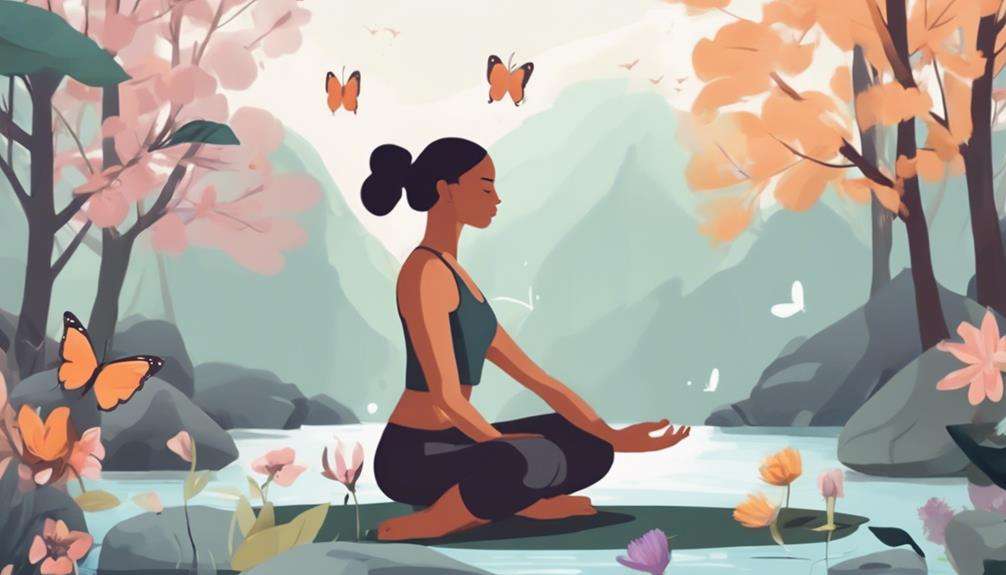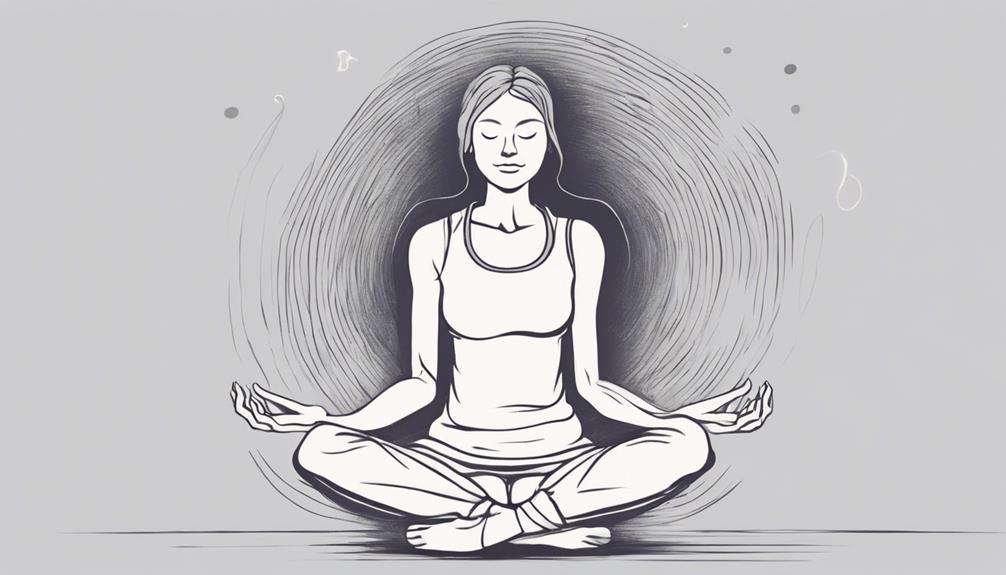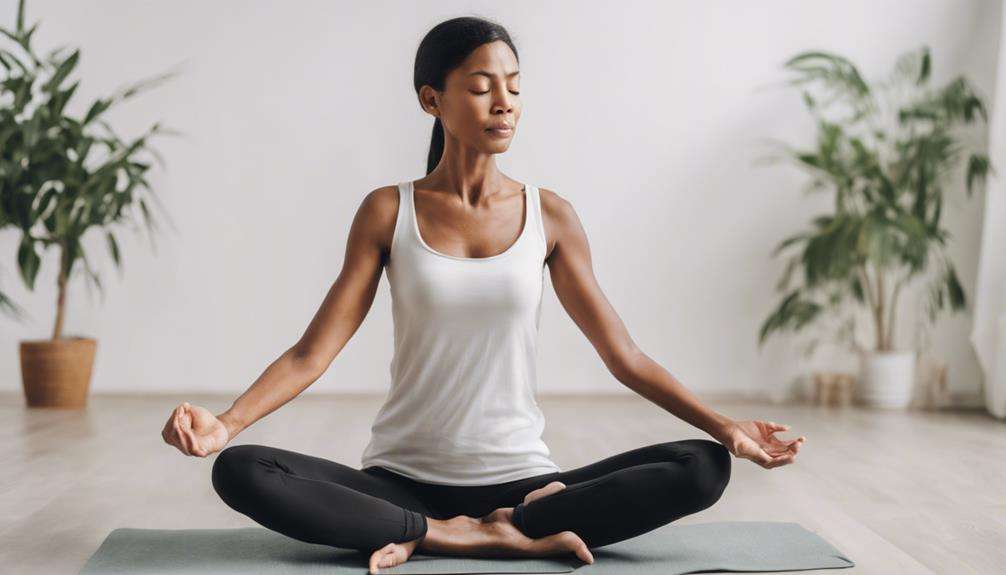Are you seeking natural ways to alleviate joint pain and enhance your overall well-being?
Discover the transformative power of specific yoga poses that target joint health and promote pain management.
These gentle yet effective poses can be a valuable addition to your wellness routine, offering relief and improved mobility.
Stay tuned to uncover how simple adjustments in your practice can make a significant difference in your joint health and overall quality of life.
Key Takeaways
- Gentle neck stretches and spinal twists improve flexibility and alleviate discomfort.
- Proper alignment and breathing techniques enhance spinal health and reduce pain.
- Modifications and beginner tips ensure safe and effective practice for joint wellness.
- Restorative poses like Child's Pose and Cobra alleviate joint pain and enhance relaxation.
Gentle Neck Stretches
Gently stretching your neck through yoga poses can significantly enhance flexibility and alleviate tension in the neck muscles. These neck stretches are designed to reduce stiffness and discomfort in the neck area, providing a sense of relaxation and relief.
By incorporating gentle neck stretches into your routine, you may be able to prevent neck pain and improve overall mobility in this area. Additionally, these stretches help to enhance circulation to the neck region, facilitating better nutrient delivery and waste removal, which is essential for maintaining a healthy neck.
Proper alignment and mindful breathing during neck stretches are crucial components that can contribute to better posture and decreased neck strain. By focusing on these aspects, you can ensure that you're getting the most out of your neck stretches and promoting optimal neck health. Remember to listen to your body and only stretch to a comfortable limit to avoid any potential injuries.
Seated Spinal Twist
The Seated Spinal Twist offers a range of benefits, including improving spinal mobility, stretching the back muscles, and aiding digestion. This pose can also help in relieving tension in the back and shoulders, promoting detoxification by massaging the internal organs, and enhancing overall flexibility.
To ensure proper alignment in the Seated Spinal Twist, start by sitting tall with both sitting bones grounded. As you twist, keep the spine long and avoid rounding the back. Engage the core muscles to support the twist and maintain length in the spine. Remember to breathe deeply and only twist as far as comfortable without forcing the movement.
For beginners, modifications can be made to make the pose more accessible. Using a block or bolster under the hand can provide additional support and reduce strain. Gradually increasing the twist over time as flexibility improves is also advisable. Remember to listen to your body and never push into a position that causes pain or discomfort.
Benefits of Twist
Improving spine flexibility and aiding in digestion, Seated Spinal Twist (Ardha Matsyendrasana) targets the spine, hips, and shoulders with a gentle twist. This yoga pose offers numerous benefits that can help alleviate back pain and improve overall wellness:
- Relief from Lower Back Pain: Ardha Matsyendrasana helps relieve lower back pain and discomfort associated with sciatica.
- Enhanced Digestion: The twist stimulates the abdominal organs, aiding in detoxification and digestion.
- Improved Spinal Health: Regular practice of Seated Spinal Twist can enhance overall spinal health and mobility.
Incorporating Seated Spinal Twist into your routine can't only provide physical relief but also contribute to a sense of well-being and vitality.
Proper Alignment Tips
To achieve optimal alignment in Seated Spinal Twist, focus on engaging your core muscles and maintaining a straight spine throughout the pose. This alignment is crucial for preventing strain on your back and ensuring that the twist targets the intended areas effectively.
Be mindful of your knee placement during this pose to avoid any unnecessary pressure or discomfort. If you experience knee pain, you can place a blanket or cushion under the bent knee for support.
Keeping your spine elongated and your core activated won't only enhance the benefits of the twist but also protect your knees from any potential strain. Remember, proper alignment is key to a safe and beneficial practice.
Modification for Beginners
If you're just starting out with the Seated Spinal Twist, consider using props like a block or blanket for added support to ease into the pose comfortably. This modification for beginners can help you gradually build flexibility and experience the pain relief benefits of this gentle twist.
Here are some tips to assist you in your practice:
- Start Slow: Allow your body to adjust to the movement, focusing on your breath for a calming effect.
- Engage Core Muscles: Support your spine by gently engaging your core muscles throughout the twist.
- Listen to Your Body: If you feel any discomfort or pain, ease out of the pose and make necessary adjustments to ensure a safe practice.
Cat-Cow Pose
Let's explore the key aspects of Cat-Cow Pose to help you make the most of this beneficial yoga posture.
Focus on aligning your spine in Cat-Cow, utilizing the breathing techniques for optimal benefits, and consider modifications if you're new to this pose.
Alignment in Cat-Cow
When aligning your spine in Cat-Cow Pose, focus on moving between arched and rounded back positions to improve flexibility and core strength. Proper alignment is key to prevent strain on the neck and lower back.
Here are three essential tips for achieving optimal alignment in Cat-Cow:
- Engage your core muscles: By activating your core, you support your spine and enhance stability during the movements.
- Relax your shoulders: Ensure your shoulders are relaxed and away from your ears to avoid tension buildup in the upper body.
- Maintain a neutral neck position: Keep your neck in line with your spine to prevent unnecessary strain on the cervical vertebrae.
Breathing Technique Benefits
To fully benefit from Cat-Cow Pose, focus on syncing your breath with each movement to enhance relaxation and spinal flexibility. This breathing technique helps coordinate the arching and rounding of your back, promoting stress reduction and improved circulation to the spine.
By incorporating deep inhales and exhales, you can enhance your lung capacity and boost overall respiratory function. The rhythmic nature of breathing in Cat-Cow Pose can also aid in strengthening your core muscles and improving posture.
Additionally, the gentle movement in this pose can provide relief to knee joints by increasing flexibility and reducing tension in the surrounding muscles. Practice mindfulness as you flow through Cat-Cow Pose, allowing your breath to guide each movement for optimal benefits.
Modifications for Beginners
For beginners looking to ease into Cat-Cow Pose, consider aligning your wrists under shoulders and knees under hips to establish a stable foundation for the movement. When focusing on the right leg during this pose, remember to keep the movement gentle and controlled to avoid strain or discomfort.
Here are some modifications to help you perfect your Cat-Cow Pose:
- Use a yoga block under your hand for added support and stability.
- Engage your core muscles to protect your lower back and enhance the stretch.
- Imagine a string pulling your spine towards the ceiling to maintain proper alignment.
Child's Pose
Embrace relaxation and gentle stretching with the soothing yoga pose known as Child's Pose, or Balasana. This restful posture offers a myriad of benefits for your body and mind.
As you ease into Child's Pose, allow your attention to drift towards your right knee, feeling a gentle stretch in this area. Balasana is a wonderful way to release tension in your lower back, hips, thighs, and ankles, providing relief for any discomfort you may be experiencing in these areas. By elongating the spine and focusing on your breath, you can alleviate back and neck pain while promoting a sense of calmness and inner peace.
Moreover, practicing Child's Pose regularly can enhance your posture, boost flexibility, and offer a soothing release for tight muscles throughout your body. Remember to breathe deeply as you sink into this pose, allowing your lungs to expand and improve your respiratory function. Embrace the tranquility that Child's Pose brings, nurturing your body and mind with each peaceful moment spent in this restorative posture.
Cobra Pose

Are you looking to strengthen your spine and open your chest while improving flexibility in your back muscles and alleviating lower back pain? Cobra Pose, also known as Bhujangasana, could be the perfect addition to your yoga routine. Here's why you should consider incorporating this pose into your practice:
- Strengthens Your Back Muscles: Cobra Pose targets the muscles along your spine, helping to build strength and stability in this crucial area.
- Alleviates Lower Back Pain: By gently stretching and strengthening the back muscles, Cobra Pose can provide relief from discomfort in the lower back.
- Improves Posture and Flexibility: Regular practice of Cobra Pose can lead to improved posture and increased flexibility in the back muscles, which can contribute to overall spinal health.
Downward-Facing Dog
Stretch and strengthen your entire body with the popular yoga pose Downward-Facing Dog, benefiting your shoulders, arms, back, and legs. This pose isn't only a great way to build strength but also to enhance flexibility. By practicing Downward-Facing Dog, you can improve the flexibility in your hamstrings, calves, and spine, which is crucial for joint health and pain management. The elongating effect on these areas can help alleviate stiffness and discomfort, leading to increased mobility and reduced pain.
Furthermore, Downward-Facing Dog offers more than just physical benefits. It promotes mental clarity by increasing blood flow to the brain, helping to reduce stress and anxiety. As you flow through this pose, focus on your breath and find a sense of calm and relaxation. Remember that modifications are available to suit your needs. Whether you bend your knees slightly or use props for support, make this pose work for your body. Regular practice of Downward-Facing Dog can contribute to improved posture, joint health, and overall well-being.
Extended Triangle Pose
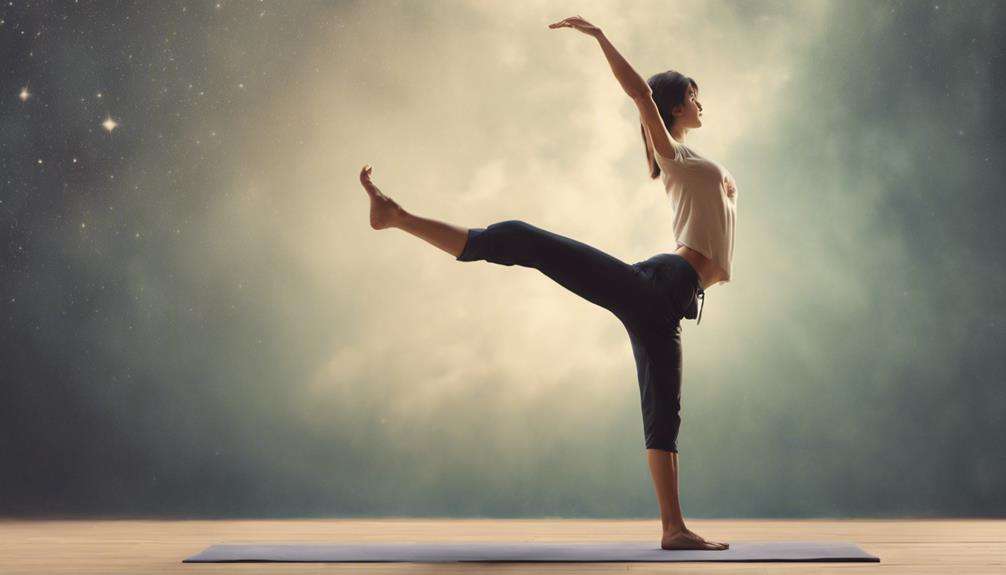
Enhance your yoga practice and promote physical well-being with the foundational Extended Triangle Pose, also known as Utthita Trikonasana. This yoga pose isn't only a great stretch but also a powerful way to improve your overall wellness. Here's why you should incorporate Utthita Trikonasana into your yoga practices:
- Strengthens and Stretches: Utthita Trikonasana targets the legs, hips, and spine, helping to build strength and flexibility in these areas.
- Mind-Body Connection: By practicing this pose, you can enhance your balance and coordination while also calming the mind and reducing stress levels.
- Digestive Support: The stimulation of abdominal organs in Extended Triangle Pose can aid in digestion, promoting better gut health and overall well-being.
Seated Forward Bend
Gently folding forward from a seated position, the Seated Forward Bend, also known as Paschimottanasana, offers a soothing stretch for your spine and hamstrings. This yoga pose targets the hamstrings, lower back, and spine, helping to release tension and enhance flexibility in these areas. By practicing Paschimottanasana, you can experience relief from back pain and improve the range of motion in your posterior muscles.
Apart from the physical benefits, Seated Forward Bend is also effective in calming the mind, reducing stress, and alleviating anxiety. The pose stimulates the abdominal organs, which can aid in digestion and ease any discomfort in the digestive system. Regular practice of Paschimottanasana is known to enhance blood circulation throughout the body, promoting better energy levels and overall well-being.
Next time you need a gentle stretch that targets your hamstrings and spine while also providing mental relaxation, consider incorporating the Seated Forward Bend into your yoga routine.
Legs Up the Wall Pose
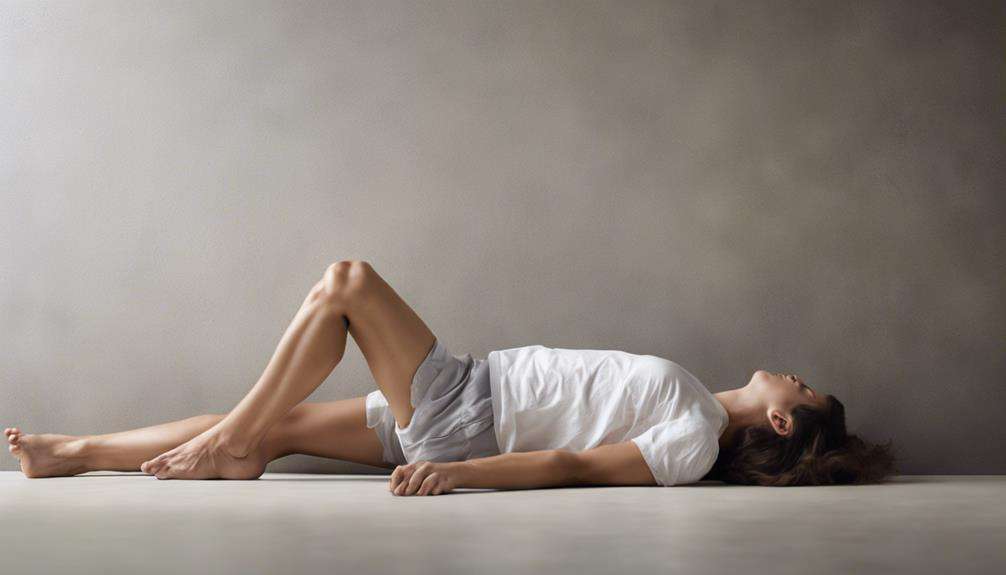
After soothing your spine and hamstrings with the Seated Forward Bend, consider trying the restorative Legs Up the Wall Pose, also known as Viparita Karani, to relieve tension and fatigue in your legs. This gentle yoga pose offers numerous benefits for your lower body and overall well-being:
- Relief from Leg Discomfort: By elevating your legs vertically against the wall, you can reduce swelling and discomfort in your legs and feet, especially beneficial for those dealing with joint pain or inflammation.
- Promotes Relaxation: The calming nature of the pose helps relax both your mind and body, aiding in stress reduction and promoting a sense of tranquility.
- Enhances Circulation: Legs Up the Wall Pose improves blood flow to your legs, which can help alleviate symptoms of various conditions like arthritis, varicose veins, and restless leg syndrome.
Incorporating Legs Up the Wall Pose into your daily routine for a few minutes can significantly contribute to your overall wellness and provide relief from leg-related issues.
Frequently Asked Questions
Which Yoga Is Best for Joint Pain?
For joint pain relief, chair yoga offers gentle movements and support. It helps increase flexibility, strength, and mobility without strain. Incorporate poses like seated twists and leg stretches to improve joint health and overall well-being.
What Is the Best Yoga for Seniors With Arthritis?
For seniors with arthritis, chair yoga offers gentle stretching and movement while seated. Poses like Cat-Cow, Child's Pose, and Gentle Seated Twist can improve flexibility and reduce pain. Incorporating chair yoga can enhance mobility and reduce stiffness.
Can Yoga Help With Pain Management?
Yoga benefits extend beyond the physical, offering a holistic approach to pain management. By incorporating yoga into your routine, you can experience improved flexibility, reduced inflammation, and enhanced well-being, leading to better joint health.
Does Yoga Help Joint Inflammation?
Yoga benefits your joints by reducing inflammation, increasing circulation, and improving mobility. Regular practice of yoga poses can effectively manage joint inflammation, providing relief and enhancing your overall well-being. Start incorporating yoga into your routine today.
Conclusion
Incorporating these yoga poses into your daily routine can help alleviate joint pain and improve overall wellness.
Did you know that a study published in the Journal of Pain Research found that regular yoga practice can reduce joint pain by up to 30%?
Remember to listen to your body, seek guidance from a qualified instructor, and practice mindfully to experience the full benefits of these poses.
Your journey to pain management and better joint health starts with a simple yoga practice.



